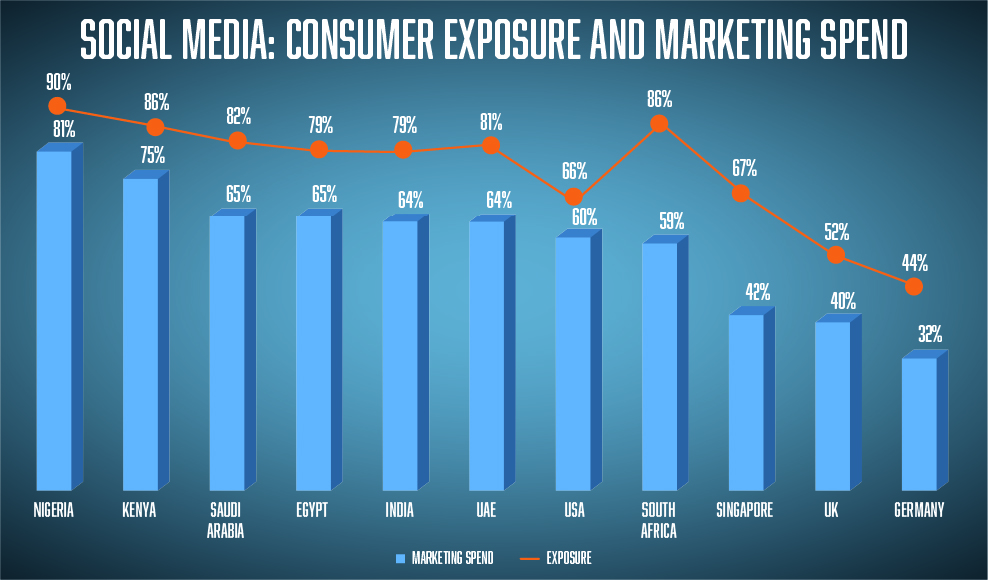How has the pandemic affected the various marketing mediums, and marketers’ thinking? Has there been a paradigm shift towards digital mediums versus traditional channels of marketing? Which media channels are trusted the most by consumers?
To understand these questions and more about the current marketing landscape, Borderless Access surveyed both consumers and marketing professionals across 11 countries (US, UK, Germany, Nigeria, South Africa, Kenya, Egypt, UAE, Saudi Arabia, India and Singapore), painting a dipstick picture of 11 diverse but key markets across the globe.
TV still enjoys the greatest exposure in developed markets; social media in developing ones
In the USA, TV is still the channel that consumers have the greatest exposure to (67%), although this is followed closely by social media at 66%. Germany and UK are the only two countries where TV still far outperforms social media in terms of consumer channel exposure – with 70% of the Brits and 50% of Germans claiming to view this traditional channel.
In the developing markets, particularly in Africa and the Middle East, social media has risen to number one position in terms of consumer exposure, with a staggering 90% of Nigerians claiming to use this channel, strongly reinforcing the notion that Africa is catching up with developed markets in the digital revolution.
India shows strong engagement with both TV and social media, with exposure up at 78% and 79% respectively for these two channels.
Traditional channels still elicit the most trust
In almost every country studied, TV still comes out top in consumer’s minds, when asked which channels they trust the most for product or service information. This finding is true even in countries where exposure to digital channels has surpassed TV exposure. One exception to this is South Africa, where tried-and-tested radio still elicits the most trust, followed by TV in second place.
The only country in which social media elicits more trust than TV is Egypt, which has an exposure of 79% to this relatively new channel.

So, how does this stack up against where the marketing and media professionals are focussing their attention?
Marketing spend has a strong digital focus, largely due to its price differential from TV
Not surprisingly, marketers are focusing heavily on social media across most countries – this trend being one that had already started pre-Covid-19. Other digital channels (websites, digital publications and mobile apps) are also receiving a fair amount of attention in developing and developed markets alike.
In Nigeria for example we see 81% of marketing professionals claiming to be spending on social media, whereas in the USA and UK this number is 60% and 40% respectively. In contrast, 48% of marketers in the USA and 20% in the UK claim to currently spend on TV. In Germany, only 10% of marketers are currently spending on this traditional channel, yet despite this, it continues to be the channel with the greatest consumer exposure.
Of course, a notable reason for fewer marketers focusing their spend on TV is the vast cost differential between advertising on social media vs on TV. Despite this differential, the high exposure reinforces the strength that this channel continues to hold in the minds of consumers.
Usage of social media is driven by marketing
The sub-Saharan African countries lead the way in terms of exposure to social media as a channel. When we overlay this finding next to marketing spend, we see that the majority of countries in the sub-Saharan and Middle East regions are pushing focus on this channel, with exposure closely following suit.
Singapore, the UK and Germany show a very different trend, with little marketing focus (42% and lower) on this channel, resulting in lower consumer exposure to it.
In all cases, it is clear that marketing spend is directly affecting consumer awareness of and exposure to the channel.

Digital focus is important but don’t lose sight of traditional channels
It is indisputable that digital channels are the current focus of both marketers and consumers – and that they continue to grow.
However, traditional channels – led by TV – still hold a great deal of trust in the minds of the consumer, and also hold the ability to trigger a purchase. These channels still hold a great deal of weight in the minds of consumers, eliciting a sense of familiarity and comfort.
As many countries worldwide are now in the throng of their third wave of Covid-19, it is clear that marketers and consumers alike will continue to rely more and more on digital channels. However, marketers would therefore be cautioned not to turn their backs on traditional channels but instead to retain a balanced approach between digital and traditional marketing channels. The optimum way forward surely involves embracing the ground-breaking developments of the new but also holding onto the trust and reliance that consumers have for the old.
Borderless Access provides access to its first-party hyper-niche digital audiences across consumer and B2B panels, amongst others. For more information, please contact us.
About the study:
This was an online study was conducted towards the beginning of 2021 over 3 weeks. The study covered the US, UK, Germany, Nigeria, South Africa, Kenya, Egypt, UAE, Saudi Arabia, India and Singapore markets. Our respondents were comprised of both consumers as well as advertising and marketing decision-makers (Senior Manager level and above), with a sample of 200 consumers and 200 advertisers/ marketers from each market.


